Impact of Deficit Drip Irrigation with Brackish Water on Soil Water–Salt Dynamics and Maize Yield in Film-Mulched Fields
Abstract
1. Introduction
2. Materials and Methods
2.1. Experimental Site
2.2. Experimental Design
2.3. Sampling and Measurement
2.3.1. Soil Physical Parameters
2.3.2. Determination of Maize Growth and Yield
2.4. Path Analysis
2.5. Statistical Analysis
3. Results
3.1. Soil Water Storage
3.2. Soil Salinity
3.3. Soil Temperature
3.4. Maize Growth
3.5. Maize Yield and Water Productivity
3.6. Direct Correlation Coefficients Between Maize Yield and Growth Indicators
4. Discussion
4.1. Effects of Brackish Water Deficit Irrigation on Soil Water Salinity
4.2. Effect of Brackish Water Deficit Irrigation on Soil Temperature
4.3. Effects of Brackish Water Deficit Irrigation on Growth, Yield, and WP of Maize
4.4. Effect of Soil Water–Heat–Salt Conditions on Growth and Yield of Maize
5. Conclusions
Author Contributions
Funding
Data Availability Statement
Conflicts of Interest
References
- Cheng, M.; Wang, H.; Fan, J.; Wang, X.; Sun, X.; Yang, L.; Zhang, S.; Xiang, Y.; Zhang, F. Crop yield and water productivity under salty water irrigation: A global meta-analysis. Agric. Water Manag. 2021, 256, 107105. [Google Scholar] [CrossRef]
- Jiang, Q.; Peng, J.; Biswas, A.; Hu, J.; Zhao, R.; He, K.; Shi, Z. Characterising dryland salinity in three dimensions. Sci. Total Environ. 2019, 682, 190–199. [Google Scholar] [CrossRef] [PubMed]
- van Zelm, E.; Zhang, Y.; Testerink, C. Salt Tolerance Mechanisms of Plants. Annu. Rev. Plant Biol. 2020, 71, 403–433. [Google Scholar] [CrossRef] [PubMed]
- Ray, D.K.; Mueller, N.D.; West, P.C.; Foley, J.A. Yield Trends Are Insufficient to Double Global Crop Production by 2050. PLoS ONE 2013, 8, e66428. [Google Scholar] [CrossRef] [PubMed]
- Dong, X.; Wang, J.; Zhang, X.; Dang, H.; Singh, B.P.; Liu, X.; Sun, H. Long-term saline water irrigation decreased soil organic carbon and inorganic carbon contents. Agric. Water Manag. 2022, 270, 107760. [Google Scholar] [CrossRef]
- Wang, H.; Zheng, C.; Ning, S.; Cao, C.; Li, K.; Dang, H.; Wu, Y.; Zhang, J. Impacts of long-term saline water irrigation on soil properties and crop yields under maize-wheat crop rotation. Agric. Water Manag. 2023, 286, 108383. [Google Scholar] [CrossRef]
- Wei, K.; Zhang, J.; Wang, Q.; Guo, Y.; Mu, W. Irrigation with ionized brackish water affects cotton yield and water use efficiency. Ind. Crops Prod. 2022, 175, 114244. [Google Scholar] [CrossRef]
- Beltrano, J.; Ruscitti, M.; Arango, M.C.; Ronco, M. Effects of arbuscular mycorrhiza inoculation on plant growth, biological and physiological parameters and mineral nutrition in pepper grown under different salinity and p levels. J. Soil Sci. Plant Nutr. 2013, 13, 123–141. [Google Scholar] [CrossRef]
- Bai, Y.; Zhang, T.; Zhai, Y.; Shen, X.; Ma, X.; Zhang, R.; Ji, C.; Hong, J. Water footprint coupled economic impact assessment for maize production in China. Sci. Total Environ. 2021, 752, 141963. [Google Scholar] [CrossRef]
- Kisekka, I.; Schlegel, A.; Ma, L.; Gowda, P.H.; Prasad, P.V.V. Optimizing preplant irrigation for maize under limited water in the High Plains. Agric. Water Manag. 2017, 187, 154–163. [Google Scholar] [CrossRef]
- Wang, F.; Meng, H.; Xie, R.; Wang, K.; Ming, B.; Hou, P.; Xue, J.; Li, S. Optimizing deficit irrigation and regulated deficit irrigation methods increases water productivity in maize. Agric. Water Manag. 2023, 280, 108205. [Google Scholar] [CrossRef]
- He, Q.; Li, S.; Kang, S.; Yang, H.; Qin, S. Simulation of water balance in a maize field under film-mulching drip irrigation. Agric. Water Manag. 2018, 210, 252–260. [Google Scholar] [CrossRef]
- Ma, K.; Wang, Z.; Li, H.; Wang, T.; Chen, R. Effects of nitrogen application and brackish water irrigation on yield and quality of cotton. Agric. Water Manag. 2022, 264, 107512. [Google Scholar] [CrossRef]
- Ma, Z.; Liu, J.; Zhang, J.; Yin, F.; Guo, L.; Wen, Y.; Song, L.; Zhu, Y.; Liang, Y.; Wang, Z. Ultra-wide film mulching with moderate irrigation water salinity enhances cotton growth under drip irrigation in Xinjiang, China. Field Crops Res. 2024, 315, 109485. [Google Scholar] [CrossRef]
- Yavuz, D.; Kılıç, E.; Seymen, M.; Dal, Y.; Kayak, N.; Kal, Ü.; Yavuz, N. The effect of irrigation water salinity on the morph-physiological and biochemical properties of spinach under deficit irrigation conditions. Sci. Hortic. 2022, 304, 111272. [Google Scholar] [CrossRef]
- Ren, F.; Yang, G.; Li, W.; He, X.; Gao, Y.; Tian, L.; Li, F.; Wang, Z.; Liu, S. Yield-compatible salinity level for growing cotton (Gossypium hirsutum L.) under mulched drip irrigation using saline water. Agric. Water Manag. 2021, 250, 106859. [Google Scholar] [CrossRef]
- Wang, X.; Yang, J.; Liu, G.; Yao, R.; Yu, S. Impact of irrigation volume and water salinity on winter wheat productivity and soil salinity distribution. Agric. Water Manag. 2015, 149, 44–54. [Google Scholar] [CrossRef]
- Yuan, C.; Feng, S.; Huo, Z.; Ji, Q. Effects of deficit irrigation with saline water on soil water-salt distribution and water use efficiency of maize for seed production in arid Northwest China. Agric. Water Manag. 2019, 212, 424–432. [Google Scholar] [CrossRef]
- Qiu, Y.; Fan, Y.; Chen, Y.; Hao, X.; Li, S.; Kang, S. Response of dry matter and water use efficiency of alfalfa to water and salinity stress in arid and semiarid regions of Northwest China. Agric. Water Manag. 2021, 254, 106934. [Google Scholar] [CrossRef]
- Hu, Y.; Li, X.; Jin, M.; Wang, R.; Chen, J.; Guo, S. Reduced co-occurrence and ion-specific preferences of soil microbial hub species after ten years of irrigation with brackish water. Soil Tillage Res. 2020, 199, 104599. [Google Scholar] [CrossRef]
- Wang, Z.; Li, Z.; Zhan, H.; Yang, S. Effect of long-term saline mulched drip irrigation on soil-groundwater environment in arid Northwest China. Sci. Total Environ. 2022, 820, 153222. [Google Scholar] [CrossRef] [PubMed]
- Paltineanu, C.; Chitu, E. Climate change impact on phenological stages of sweet and sour cherry trees in a continental climate environment. Sci. Hortic. 2020, 261, 109011. [Google Scholar] [CrossRef]
- Schuster, C.; Estrella, N.; Menzel, A. Shifting and extension of phenological periods with increasing temperature along elevational transects in southern Bavaria. Plant Biol. 2014, 16, 332–344. [Google Scholar] [CrossRef] [PubMed]
- McMaster, G.S.; Wilhelm, W.W. Is soil temperature better than air temperature for predicting winter wheat phenology? Agronomy 1998, 90, 602–607. [Google Scholar] [CrossRef]
- Xiao, C.; Ji, Q.; Zhang, F.; Li, Y.; Fan, J.; Hou, X.; Yan, F.; Liu, X.; Gong, K. Effects of various soil water potential thresholds for drip irrigation on soil salinity, seed cotton yield and water productivity of cotton in northwest China. Agric. Water Manag. 2023, 279, 108172. [Google Scholar] [CrossRef]
- Gong, X.; Qiu, R.; Sun, J.; Ge, J.; Li, Y.; Wang, S. Evapotranspiration and crop coefficient of tomato grown in a solar greenhouse under full and deficit irrigation. Agric. Water Manag. 2020, 235, 106154. [Google Scholar] [CrossRef]
- Gao, J.; Liu, N.; Wang, X.; Niu, Z.; Liao, Q.; Ding, R.; Du, T.; Kang, S.; Tong, L. Maintaining grain number by reducing grain abortion is the key to improve water use efficiency of maize under deficit irrigation and salt stress. Agric. Water Manag. 2024, 294, 108727. [Google Scholar] [CrossRef]
- Wang, W.; Rong, Y.; Dai, X.; Zhang, C.; Wang, C.; Huo, Z. Variation and attribution of energy distribution for salinized sunflower farmland in arid area. Agric. Water Manag. 2024, 297, 108833. [Google Scholar] [CrossRef]
- Ding, R.S.; Kang, S.Z.; Li, F.S.; Zhang, Y.Q.; Tong, L. Evapotranspiration measurement and estimation using modified Priestley-Taylor model in an irrigated maize field with mulching. Agric. Meteorol. 2013, 168, 140–148. [Google Scholar] [CrossRef]
- Huo, Z.; Feng, S.; Kang, S.; Dai, X.; Li, W.; Chen, S. The Response of Water-Land Environment to Human Activities in Arid Minqin Oasis, Northwest China. Arid Soil Res. Rehabil. 2007, 21, 21–36. [Google Scholar] [CrossRef]
- Zhang, W.; Zhu, G.; Zhao, L.; Wang, L.; Qiu, D.; Ye, L.; Lu, S.; Lin, X. Quantifying the changes in solute transport caused by human influence on river connectivity in inland river basins. CATENA 2024, 246, 108360. [Google Scholar] [CrossRef]
- Liao, Q.; Ding, R.; Du, T.; Kang, S.; Tong, L.; Li, S. Salinity-specific stomatal conductance model parameters are reduced by stomatal saturation conductance and area via leaf nitrogen. Sci. Total Environ. 2023, 876, 162584. [Google Scholar] [CrossRef] [PubMed]
- Chen, Y.; Wang, L.; Tong, L.; Hao, X.; Ding, R.S.; Kang, S.Z.; Li, S. Effects of biochar addition and deficit irrigation with brackish water on yield-scaled N2O emissions under drip irrigation with mulching. Agric. Water Manag. 2023, 277, 108129. [Google Scholar] [CrossRef]
- Haraguchi, T.; Marui, A.; Mori, K.; Nokano, Y. Movement of water collected by bgetables in pastic-mulching field. J. Fac. Agric. Kyushu Univ. 2003, 48, 237–245. [Google Scholar] [CrossRef]
- Wang, Q.; Huo, Z.; Zhang, L.; Wang, J.; Zhao, Y. Impact of saline water irrigation on water use efficiency and soil salt accumulation for spring maize in arid regions of China. Agric. Water Manag. 2016, 163, 125–138. [Google Scholar] [CrossRef]
- Han, W.; Jia, J.; Hu, Y.; Liu, J.; Guo, J.; Shi, Y.; Huo, H.; Gong, H. Maintenance of root water uptake contributes to salt-tolerance of a wild tomato species under salt stress. Arch. Agron. Soil Sci. 2021, 67, 205–217. [Google Scholar] [CrossRef]
- Wang, Q.; Huo, Z.; Feng, S.; Yuan, C.; Wang, J. Comparison of Spring Maize Root Water Uptake Models Under Water and Salinity Stress Validated with Field Experiment Data. Irrig. Drain. 2015, 64, 669–682. [Google Scholar] [CrossRef]
- Li, Y.; Yu, Q.; Ning, H.; Gao, Y.; Sun, J. Simulation of soil water, heat, and salt adsorptive transport under film mulched drip irrigation in an arid saline-alkali area using HYDRUS-2D. Agric. Water Manag. 2023, 290, 108585. [Google Scholar] [CrossRef]
- Qi, Z.; Feng, H.; Zhao, Y.; Zhang, T.; Yang, A.; Zhang, Z. Spatial distribution and simulation of soil moisture and salinity under mulched drip irrigation combined with tillage in an arid saline irrigation district, northwest China. Agric. Water Manag. 2018, 201, 219–231. [Google Scholar] [CrossRef]
- Quan, H.; Feng, H.; Zhang, T.; Wu, L.; Dong, Q.; Siddique, K.H.M. Response of soil water, temperature, and maize productivity to different irrigation practices in an arid region. Soil Tillage Res. 2024, 237, 105962. [Google Scholar] [CrossRef]
- Amer, K.H. Corn crop response under managing different irrigation and salinity levels. Agric. Water Manag. 2010, 97, 1553–1563. [Google Scholar] [CrossRef]
- Liao, Q.; Ding, R.; Du, T.; Kang, S.; Tong, L.; Gu, S.; Gao, S.; Gao, J. Stomatal conductance modulates maize yield through water use and yield components under salinity stress. Agric. Water Manag. 2024, 294, 108717. [Google Scholar] [CrossRef]
- Tahjib-Ul-Arif, M.; Siddiqui, M.N.; Sohag, A.A.M.; Sakil, M.A.; Rahman, M.M.; Polash, M.A.S.; Mostofa, M.G.; Tran, L.-S.P. Salicylic Acid-Mediated Enhancement of Photosynthesis Attributes and Antioxidant Capacity Contributes to Yield Improvement of Maize Plants Under Salt Stress. J. Plant Growth Regul. 2018, 37, 1318–1330. [Google Scholar] [CrossRef]
- Chen, X.; Qi, Z.; Gui, D.; Sima, M.W.; Zeng, F.; Li, L.; Li, X.; Feng, S. Responses of cotton photosynthesis and growth to a new irrigation control method under deficit irrigation. Field Crops Res. 2022, 275, 108373. [Google Scholar] [CrossRef]
- Jiang, J.; Huo, Z.; Feng, S.; Zhang, C. Effect of irrigation amount and water salinity on water consumption and water productivity of spring wheat in Northwest China. Field Crops Res. 2012, 137, 78–88. [Google Scholar] [CrossRef]
- Leogrande, R.; Vitti, C.; Lopedota, O.; Ventrella, D.; Montemurro, F. Effects of Irrigation Volume and Saline Water On Maize Yield and Soil in Southern Italy. Irrig. Drain. 2016, 65, 243–253. [Google Scholar] [CrossRef]
- Luo, M.; Zhao, Y.; Zhang, R.; Xing, J.; Duan, M.; Li, J.; Wang, N.; Wang, W.; Zhang, S.; Chen, Z.; et al. Mapping of a major QTL for salt tolerance of mature field-grown maize plants based on SNP markers. BMC Plant Biol. 2017, 17, 140. [Google Scholar] [CrossRef]
- Hütsch, B.W.; Jung, S.; Schubert, S. Comparison of Salt and Drought-Stress Effects on Maize Growth and Yield Formation with Regard to Acid Invertase Activity in the Kernels. J. Agron. Crop Sci. 2015, 201, 353–367. [Google Scholar] [CrossRef]
- Liao, Q.; Gu, S.; Kang, S.; Du, T.; Tong, L.; Wood, J.D.; Ding, R. Mild water and salt stress improve water use efficiency by decreasing stomatal conductance via osmotic adjustment in field maize. Sci. Total Environ. 2022, 805, 150364. [Google Scholar] [CrossRef]
- Gao, Y.; Lu, Y.; Wu, M.; Liang, E.; Li, Y.; Zhang, D.; Yin, Z.; Ren, X.; Dai, Y.; Deng, D.; et al. Ability to Remove Na+ and Retain K+ Correlates with Salt Tolerance in Two Maize Inbred Lines Seedlings. Front. Plant Sci. 2016, 7, 1716. [Google Scholar] [CrossRef]
- Zhang, T.; Ji, X.; Zhan, X.; Ding, Y.; Zou, Y.; Kisekka, I.; Chau, H.W.; Feng, H. Maize is stressed by salt rather than water under drip irrigation with soil matric potential higher than −50 kPa in an arid saline area. J. Agron. Crop Sci. 2021, 207, 654–668. [Google Scholar] [CrossRef]
- Frensch, J.; Hsiao, T.C. Transient Responses of Cell Turgor and Growth of Maize Roots as Affected by Changes in Water Potential. Plant Physiol. 1994, 104, 247–254. [Google Scholar] [CrossRef] [PubMed]
- Li, J.; Zhu, Q.; Jiao, F.; Yan, Z.; Zhang, H.; Zhang, Y.; Ding, Z.; Mu, C.; Liu, X.; Li, Y.; et al. Research Progress on the Mechanism of Salt Tolerance in Maize: A Classic Field That Needs New Efforts. Plants 2023, 12, 2356. [Google Scholar] [CrossRef] [PubMed]
- Taylor, D.K.; Rank, D.R.; Keiser, D.R.; Smith, B.N.; Criddle, R.S.; Hansen, L.D. Modelling temperature effects on growth–respiration relations of maize. Plant Cell Environ. 1998, 21, 1143–1151. [Google Scholar] [CrossRef]

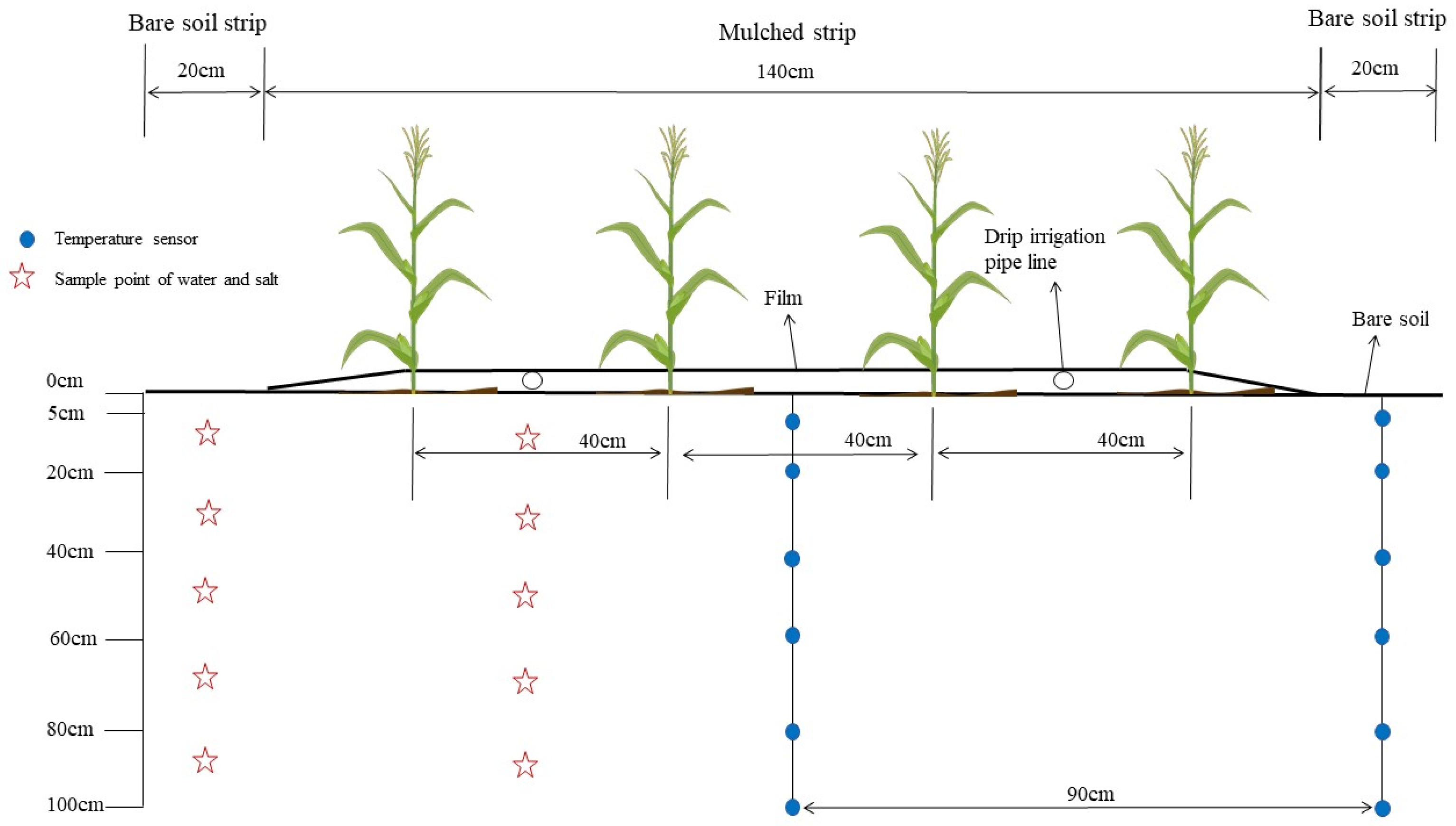
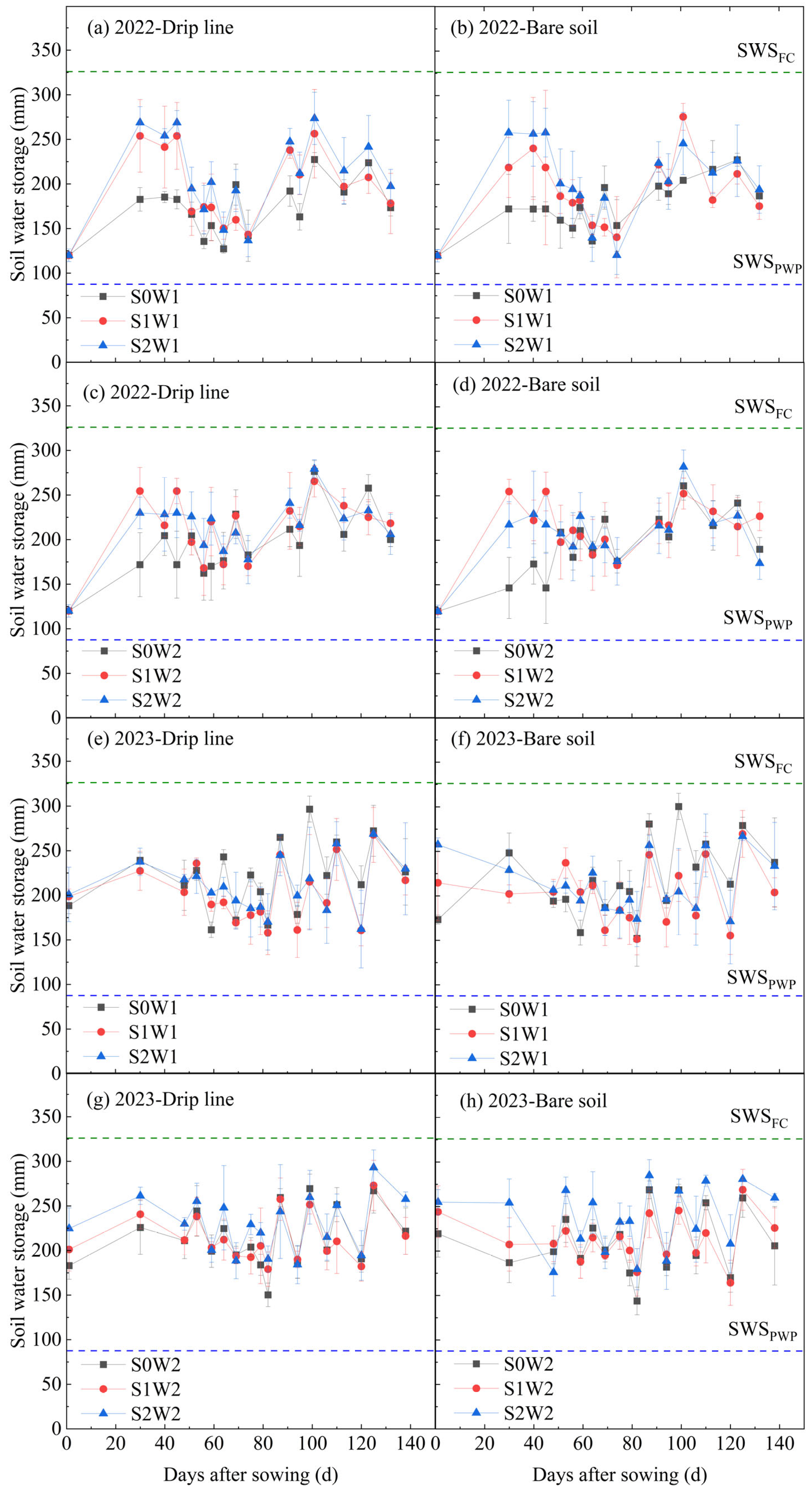
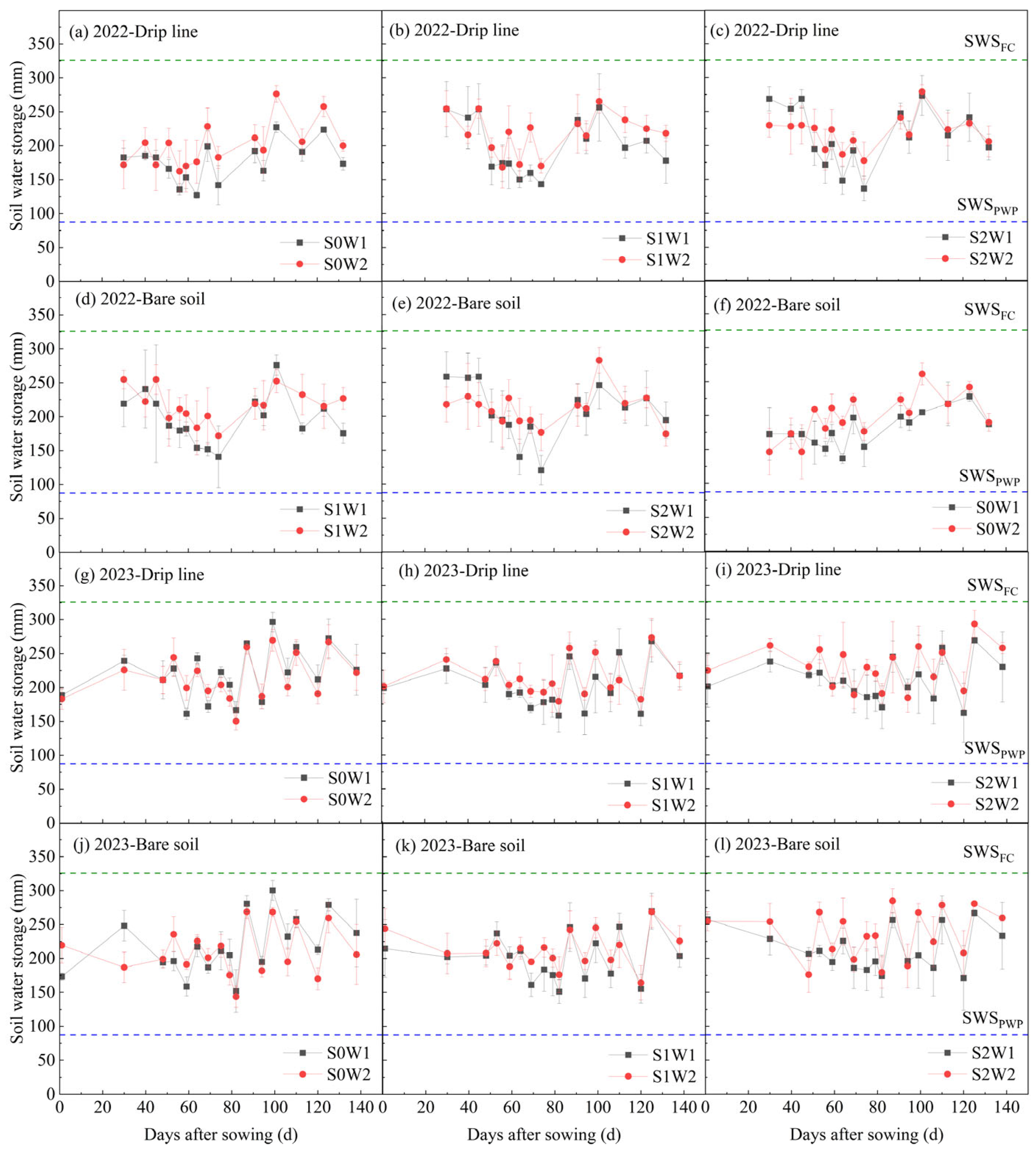

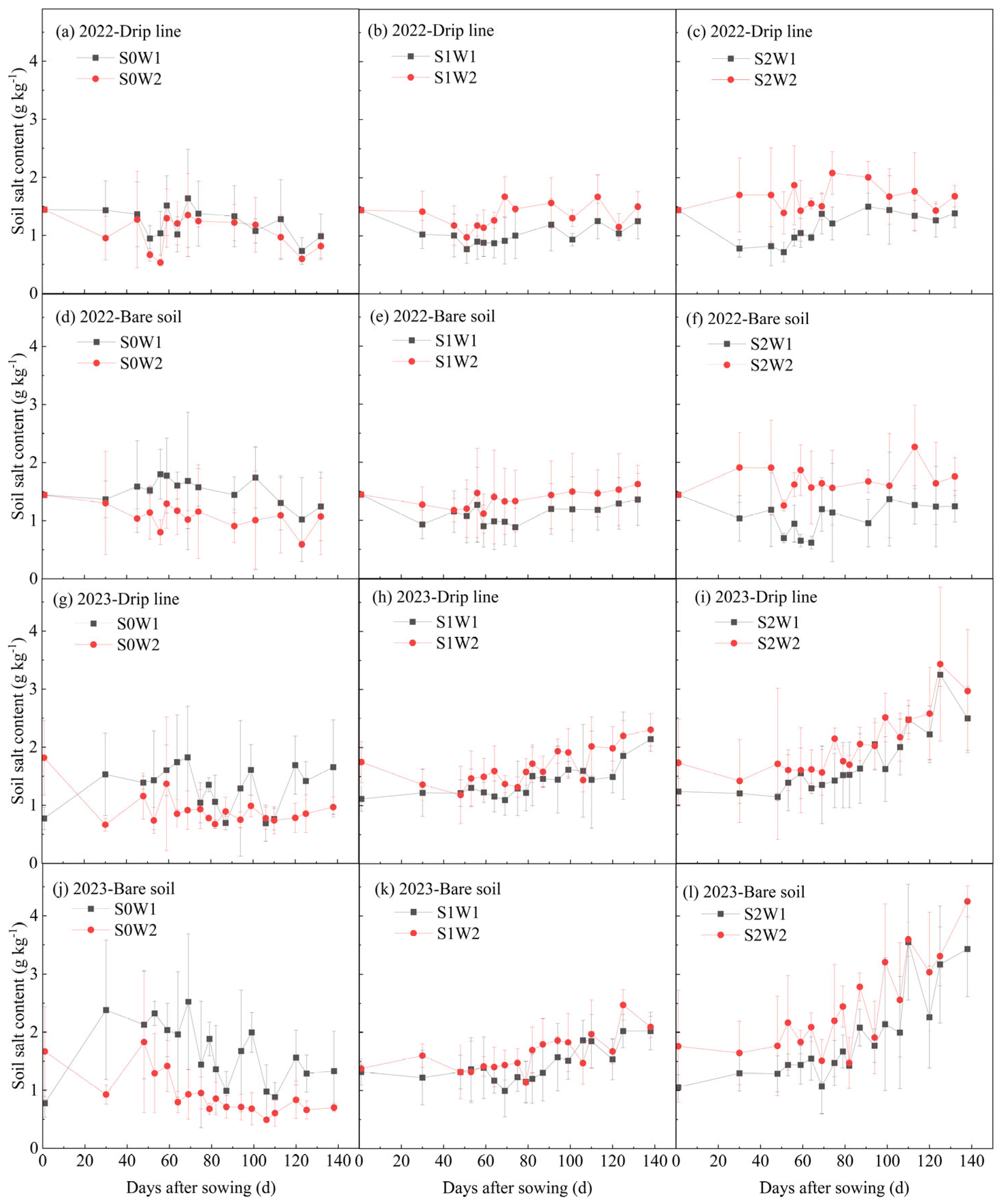

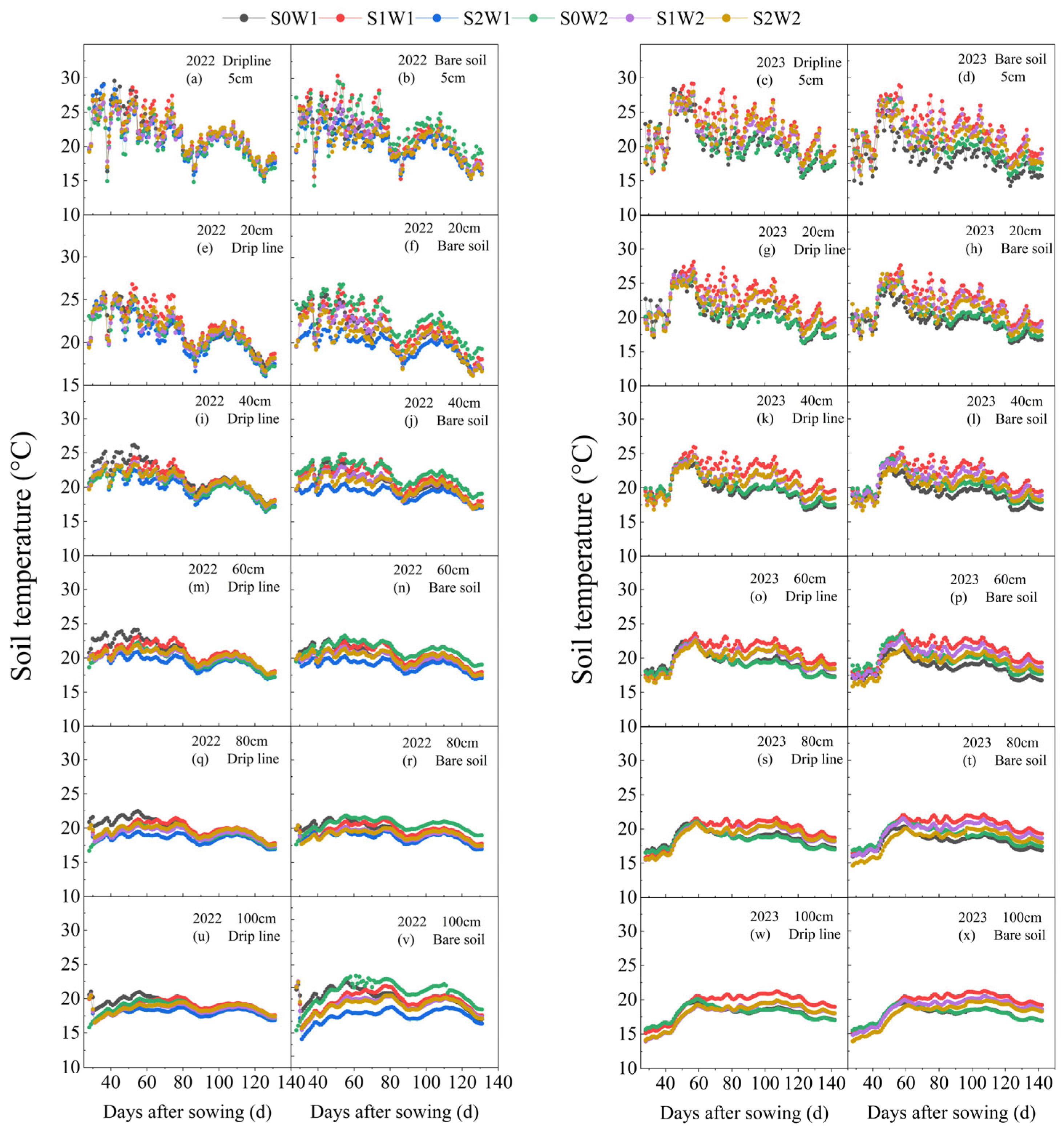
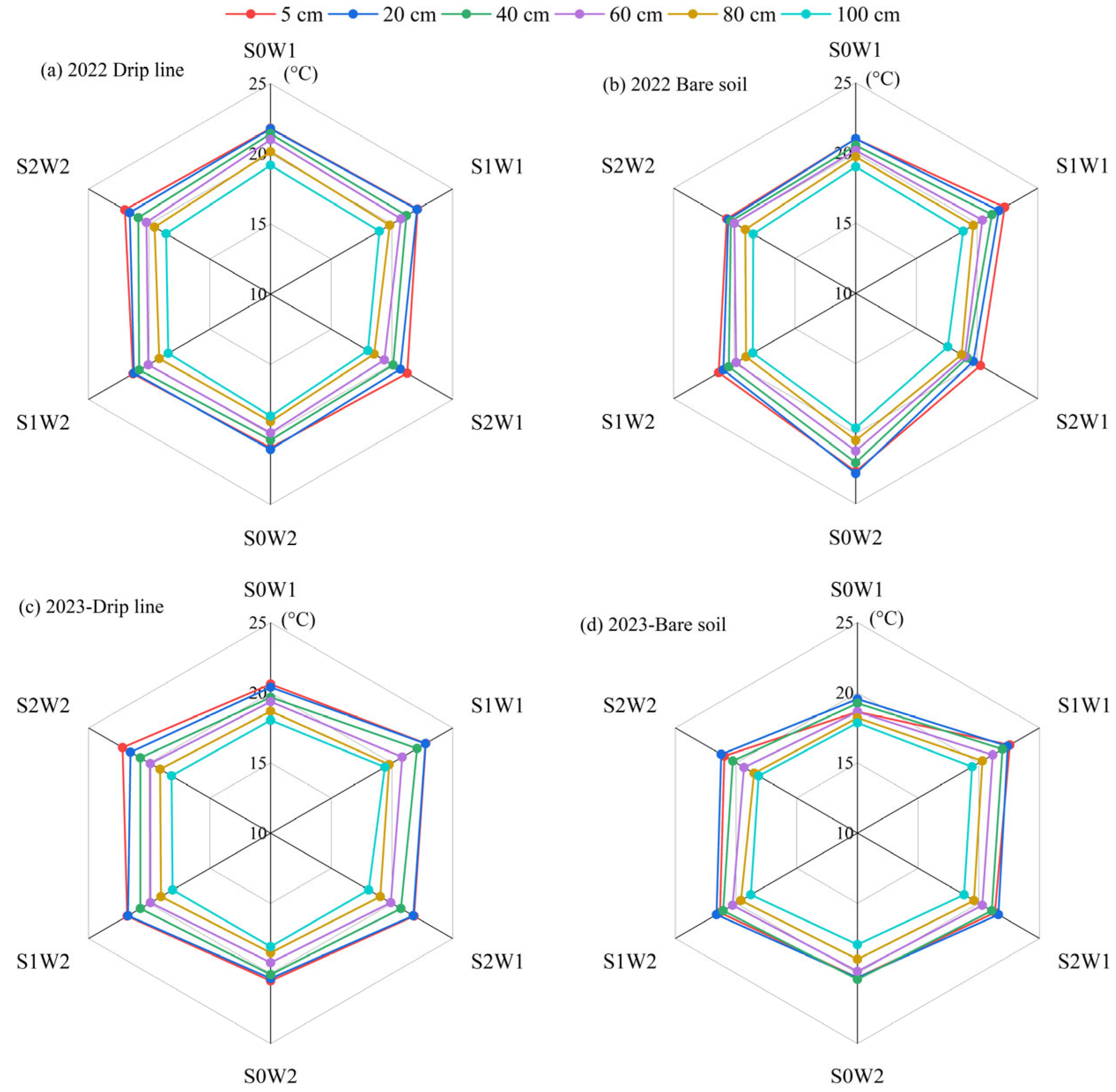

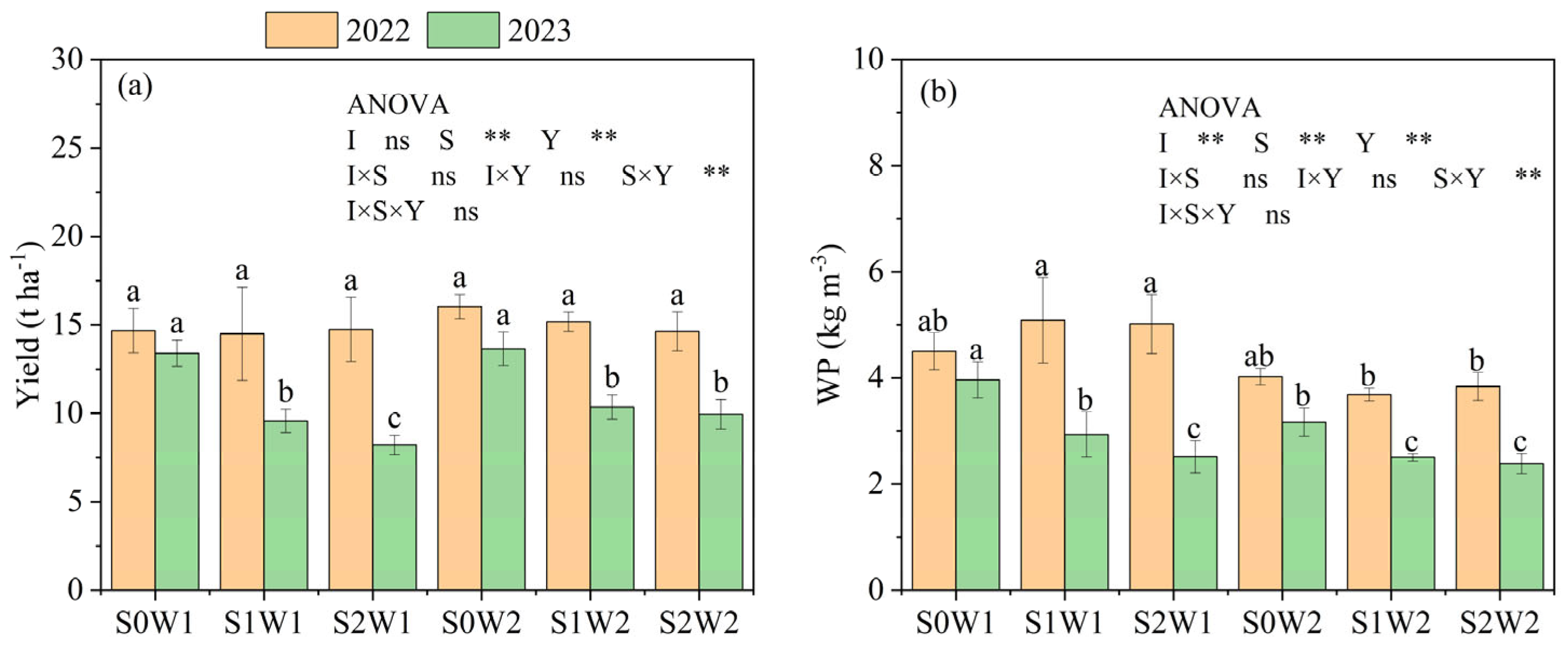
| Soil Depth | Soil Particle Size Distribution (%) | Soil Texture | Soil Bulk Density (g cm−3) | Field Capacity (cm3 cm−3) | Saturated Water Content (cm3 cm−3) | Wilting Point (cm3 cm−3) | ||
|---|---|---|---|---|---|---|---|---|
| Sand (0.05–2 mm) | Silt (0.05–0.002 mm) | Clay (<0.002 mm) | ||||||
| 0–20 cm | 27.15 | 63.58 | 9.27 | Silty loam | 1.53 | 0.28 | 0.42 | 0.074 |
| 20–40 cm | 30.17 | 60.41 | 9.42 | Silty loam | 1.48 | 0.31 | 0.46 | 0.096 |
| 40–60 cm | 17.92 | 71.12 | 10.96 | Silty loam | 1.46 | 0.34 | 0.47 | 0.075 |
| 60–80 cm | 16.97 | 73.04 | 9.99 | Silty loam | 1.58 | 0.34 | 0.46 | 0.096 |
| 80–100 cm | 35.17 | 57.07 | 7.76 | Silty loam | 1.50 | 0.36 | 0.51 | 0.097 |
| Growth Indicators | Pearson Correlation Coefficient | Direct Path Coefficient | Indirect Path Coefficient | Decision Coefficient | ||||
|---|---|---|---|---|---|---|---|---|
| Total | PH | SD | LAI | DMA | ||||
| PH | 0.843 | 0.886 | −0.043 | 0.027 | −0.080 | 0.010 | 0.709 | |
| SD | 0.406 | 0.066 | 0.314 | 0.362 | −0.046 | −0.003 | 0.050 | |
| LAI | 0.272 | −0.168 | 0.440 | 0.424 | 0.008 | −0.009 | −0.120 | |
| DMA | −0.192 | −0.053 | −0.138 | −0.170 | 0.004 | −0.028 | 0.018 | |
| Growth Indicators | Factors | Pearson Correlation Coefficient | Direct Path Coefficient | Indirect Path Coefficient | Decision Coefficient | |||
|---|---|---|---|---|---|---|---|---|
| Total | SWC | ST | SCC | |||||
| PH | SWC | −0.451 | −0.312 | −0.139 | 0.081 | −0.219 | 0.184 | |
| ST | −0.362 | −0.264 | −0.098 | 0.095 | −0.194 | 0.121 | ||
| SSC | −0.783 | −0.576 | −0.208 | −0.119 | −0.089 | 0.570 | ||
| SD | SWC | −0.544 | −0.759 | −0.265 | −0.141 | −0.124 | 0.250 | |
| ST | 0.172 | 0.463 | 0.122 | 0.231 | −0.109 | −0.055 | ||
| SSC | −0.215 | −0.325 | −0.134 | −0.289 | 0.156 | 0.034 | ||
| LAI | SWC | −0.339 | −0.066 | −0.379 | −0.166 | −0.213 | 0.040 | |
| ST | 0.026 | 0.544 | −0.168 | 0.002 | −0.188 | −0.268 | ||
| SSC | −0.520 | −0.560 | 0.158 | −0.025 | 0.183 | 0.269 | ||
| DMA | SWC | 0.103 | 0.251 | −0.148 | 0.078 | −0.226 | −0.011 | |
| ST | −0.533 | −0.257 | −0.276 | −0.077 | −0.200 | 0.208 | ||
| SSC | −0.585 | −0.594 | 0.009 | 0.096 | −0.086 | 0.342 | ||
Disclaimer/Publisher’s Note: The statements, opinions and data contained in all publications are solely those of the individual author(s) and contributor(s) and not of MDPI and/or the editor(s). MDPI and/or the editor(s) disclaim responsibility for any injury to people or property resulting from any ideas, methods, instructions or products referred to in the content. |
© 2025 by the authors. Licensee MDPI, Basel, Switzerland. This article is an open access article distributed under the terms and conditions of the Creative Commons Attribution (CC BY) license (https://creativecommons.org/licenses/by/4.0/).
Share and Cite
Guo, T.; Huang, X.; Feng, K.; Mao, X. Impact of Deficit Drip Irrigation with Brackish Water on Soil Water–Salt Dynamics and Maize Yield in Film-Mulched Fields. Agronomy 2025, 15, 379. https://doi.org/10.3390/agronomy15020379
Guo T, Huang X, Feng K, Mao X. Impact of Deficit Drip Irrigation with Brackish Water on Soil Water–Salt Dynamics and Maize Yield in Film-Mulched Fields. Agronomy. 2025; 15(2):379. https://doi.org/10.3390/agronomy15020379
Chicago/Turabian StyleGuo, Tongkai, Xi Huang, Kewei Feng, and Xiaomin Mao. 2025. "Impact of Deficit Drip Irrigation with Brackish Water on Soil Water–Salt Dynamics and Maize Yield in Film-Mulched Fields" Agronomy 15, no. 2: 379. https://doi.org/10.3390/agronomy15020379
APA StyleGuo, T., Huang, X., Feng, K., & Mao, X. (2025). Impact of Deficit Drip Irrigation with Brackish Water on Soil Water–Salt Dynamics and Maize Yield in Film-Mulched Fields. Agronomy, 15(2), 379. https://doi.org/10.3390/agronomy15020379





